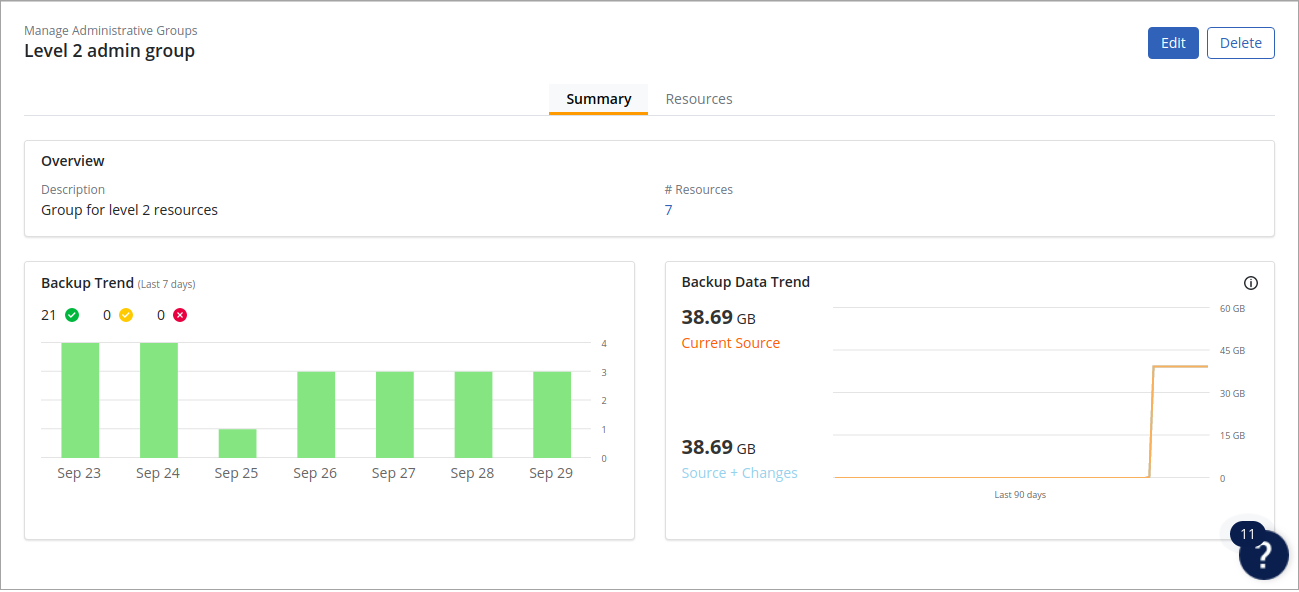Manage administrative groups
 Business
Business  Enterprise
Enterprise  Elite
Elite
Overview
An administrative group is a logical categorization of servers and virtual machines that share similar attributes. Servers can be grouped based on similar attributes like server type, server location, and operating system.
Administrative groups are formed to simplify server management. The following are the reasons why you should form an administrative group in Druva:
- Easy server administration
- Monitor the backup activity on servers through a single dashboard
Examples
- Servers located in one region, for example, US West, can be grouped together
- Servers having the same operating system can be grouped together
You can select a server from the administrative group page, and perform actions on the server such as adding a backup set, changing the server name or deleting the server.
Best practices
Follow these best practices when you create a new administrative group:
- Druva can backup data on different server types such as SQL servers, File servers, NAS Shares, Hyper-V virtual machines, and VMware virtual machines. An administrative group can have different types of servers attached to it. However, we recommend that you create different groups for different servers. For example, create a separate administrative group for virtual machines and a different administrative group for servers running MS-SQL.
- Plan and segregate virtual machines in an administrative group, depending on the criteria you have defined. For example, the location of the virtual machines, or virtual machines with a common guest operating system.
View administrative groups from Manage Administrative Groups
Create a new administrative group from Manage Administrative Groups
Add or create new VMware administrative groups based on your needs to logically categorize virtual machines.
Prerequisites
- You must be a cloud administrator.
- You must have created or configured the following,
- Druva Cloud Storage where the backed up server data should reside. For more information, see Managing storage.
- A backup policy defining the schedule for backup. For more information, see Configure backup policy.
Procedure
Update administrative group details from Manage Administrative Groups
Delete an administrative group
Enterprise Workloads administrators can delete a group if it is no longer needed. However, before deleting a group, the virtual machines belonging to this group should be assigned or moved to a different group.
Virtual machines should be reconfigured to be assigned or moved to a different group. For more information, see Reconfigure virtual machines.
As an administrative group is just a logical entity, deleting a group doesn't affect the virtual machine data anyway.
Before you delete an administrative group, reconfigure and assign all the virtual machines under it to a different group.
Procedure
Change the administrative group for configured virtual machines
If you want to regroup virtual machines, Druva lets you change the administrative group for multiple virtual machines.
To change the administrative group:
- Log in to the Management Console.
- From the top menu bar, select your organization if organizations are enabled.
- Click Protect > VMware.
- The All vCenter/ESXi host page appears that lists all the registered vCenter/hypervisors.
- You can either select the registered vCenter/ESXi host from the card view or list view or select it from the vCenter/ESXi host list in the left navigation pane.
- In the navigation pane, click Configured VMs.
- Select the virtual machines, and from more options select Change Administrative Group.
- From the Change Administrative Group dialog that appears, select a different administrative group and click Save.
Note: To edit the administrative group, click on the virtual machine. On the virtual machines summary page, click the administrative group under the Details section.




